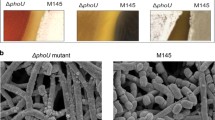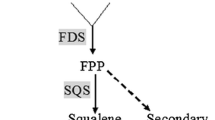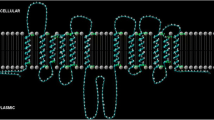Abstract
The PH081 gene encoding one of the regulators of the phosphatase regulon in Saccharomyces cerevisiae was mapped 9.8 centimorgans distal from the ser2 locus on the right arm of chromosome VII. Determination of the nucleotide sequence of cloned PH081 DNA revealed a 3537 by open reading frame encoding a 134 kDa protein. This protein has six repeats of a 33-amino acid sequence homologous to the ankyrin repeat and an asparagine-rich region. Transcription of PH081 is activated by Pho4 protein in cooperation with Pho2 (i.e., Bas2/Grf10) protein under the influence of the inorganic phosphate (Pi) concentration in the medium, through the PHO regulatory system. Major transcription initiation sites of PH081, determined by primer extension analysis, are at nucleotide positions −66 and −65 relative to the ATG codon. Deletion analysis showed that a 95 by region from nucleotide position −385 to −291 is essential for response to the Pi signals. Purified Pho4 protein protected a 19 by region (positions −350 to −332) in the 95 by fragment from DNase I digestion in vitro and the protected region includes the core sequence 5′-CACGTG-3′, which is also observed in other genes of phosphate metabolism.
Similar content being viewed by others
References
Barbaric S, Fascher K-D, Hörz W (1992) Activation of the weakly regulated PH08 promoter in S. cerevisiae: chromatin transition and binding sites for the positive regulatory protein PH04. Nucleic Acids Res 20:1031–1038
Blackwell TK, Weintraub H (1990) Differences and similarities in DNA-binding preferences of MyoD and E2A protein complexes revealed by binding site selection. Science 250:1104–1110
Botstein D, Falco SC, Stewart SE, Brennan M, Scherer S, Stinchcomb DT, Struhl K, Davis RW (1979) Sterile host yeasts (SHY): a eukaryotic system of biological containment for recombinant DNA experiments. Gene 8:17–24
Braus G, Mösch HU, Vogel K, Hinnen A, Hiitter R (1989) Interpathway regulation of the TRP4 gene of yeast. EMBO J 8:939–945
Broach JR, Strathern JN, Hicks JB (1979) Transformation in yeast development of a hybrid cloning vector and isolation of the CAN1 gene. Gene 8:121–133
Bun-ya M, Nishimura M, Harashima S, Oshima Y (1991) The PHO84 gene of Saccharomyces cerevisiae encodes an inorganic phosphate transporter. Mol Cell Biol 11:3229–3238
Coche T, Prozzi D, Legrain M, Hilger F, Vandenhaute J (1990) Nucleotide sequence of the PHO81 gene involved in the regulation of the repressible acid phosphatase gene in Saccharomyces cerevisiae. Nucleic Acids Res 18:2176
Galas DJ, Schmitz A (1978) DNAase footprinting: a simple method for the detection of protein-DNA binding specificity. Nucleic Acids Res 5:3157–3170
Hayashi N, Oshima Y (1991) Specific cis-acting sequence for PH08 expression interacts with PH04 protein, a positive regulatory factor, in Saccharomyces cerevisiae. Mol Cell Biol 11:785–794
Lux SE, John KM, Bennett V (1990) Analysis of cDNA for human erythrocyte ankyrin indicates a repeated structure with homology to tissue-differentiation and cell-cycle control proteins. Nature 344:36–42
Marinus MG, Morris NR (1975) Pleiotropic effects of a DNA adenine methylation mutation (dam-3) in Escherichia coli K12. Mutat Res 28:15–26
Matsuzaki H, Nakajima R, Nishiyama J, Araki H, Oshima Y (1990) Chromosome engineering in Saccharomyces cerevisiae by using a site-specific recombination system of a yeast plasmid. J Bacteriol 172:610–618
Mortimer RK, Contopoulou CR, King JS (1991) Genetic and physical maps of Saccharomyces cerevisiae. In: Broach JR, Pringle JR, Jones EW (eds) The molecular and cellular biology of the yeast Saccharomyces: genome dynamics, protein synthesis, and energetics. Cold Spring Harbor Laboratory, Cold Spring Harbor, New York, pp 737–812
Nishiwaki K, Hayashi N, Me S, Chung D-H, Harashima S, Oshima Y (1987) Structure of the yeast HIS5 gene responsive to general control of amino acid biosynthesis. Mol Gen Genet 208:159–167
Nishiyama M, Suzuki Y, Nogi Y, Matsumoto K, Fukasawa T (1990) Yeast Gall l protein mediates the transcriptional activation signal of two different transacting factors, Ga14 and general regulatory factor I/repressor/activator site binding protein 1/translation upstream factor. Proc Natl Acad Sci USA 87:5373–5377
Ogawa N, Oshima Y (1990) Functional domains of a positive regulatory protein, PH04, for transcriptional control of the phosphatase regulon in Saccharomyces cerevisiae. Mol Cell Biol 10:2224–2236
Oshima Y (1982) Regulatory circuits for gene expression: the metabolism of galactose and of phosphate. In: Strathern JN, Jones EW, Broach JR (eds) The molecular biology of the yeast Saccharomyces: metabolism and gene expression. Cold Spring Harbor Laboratory, Cold Spring Harbor, New York, pp 159–180
Oshima Y (1991) Impact of the Douglas-Hawthorne model as a paradigm for elucidating cellular regulatory mechanisms in fungi. Genetics 128:195–201
Perkins DD (1949) Biochemical mutants in the smut fungus Ustilago maydis. Genetics 34:607–626
Rose MD, Novick P, Thomas JH, Botstein D, Fink GR (1987) A Saccharomyces cerevisiae genomic plasmid bank based on a centromere-containing shuttle vector. Gene 60:237–243
Rudolph H, Hinnen A (1987) The yeast PH05 promoter: phosphate-control elements and sequences mediating mRNA startsite selection. Proc Natl Acad Sci USA 84:1340–1344
Sambrook J, Fritsch EF, Maniatis T (1989) Molecular cloning: a laboratory manual, 2nd edn. Cold Spring Harbor Laboratory, Cold Spring Harbor, New York
Sengstag C, Hinnen A (1988) A 28-bp segment of the Saccharomyces cerevisiae PH05 upstream activator sequence confers phosphate control to the CYCl-lacZ gene fusion. Gene 67:223–228
Shapira SK, Chou J, Richaud FV, Casadaban MJ (1983) New versatile plasmid vectors for expression of hybrid proteins coded by a cloned gene fused to lacZ gene sequences encoding an enzymatically active carboxy-terminal portion of β-galactosidase. Gene 25:71–82
Struhl K (1989) Molecular mechanisms of transcriptional regulation in yeast. Annu Rev Biochem 58:1051–1077
Studier FW, Rosenberg AH, Dunn JJ, Dubendorff JW (1990) Use of T7 RNA polymerase to direct expression of cloned genes. Methods Enzymol 185:60–89
Thompson CC, Brown TA, McKnight SL (1991) Convergence of Est- and Notch-related structural motifs in a heteromeric DNA binding complex. Science 253:762–768
Tice-Baldwin K, Fink GR, Arndt KT (1989) BAS1 has a Myb motif and activates HIS4 transcription only in combination with BAS2. Science 246:931–935
Toda T, Cameron S, Sass P, Wigler M (1988) SCH9, a gene of Saccharomyces cerevisiae that encodes a protein distinct from, but functionally and structurally related to, cAMP-dependent protein kinase catalytic subunits. Genes Dev 2:517–527
Toh-e A, Oshima Y (1974) Characterization of a dominant, constitutive mutation., PHOO, for the repressible acid phosphatase synthesis in Saccharomyces cerevisiae. J Bacteriol 120:608–617
Toh-e A, Inouye S, Oshima Y (1981) Structure and function of the PH082-pho4 locus controlling the synthesis of repressible acid phosphatase of Saccharomyces cerevisiae. J Bacteriol 145:221–232
Toh-e A, Shimauchi T (1986) Cloning and sequencing of the PH080 gene and CEN15 of Saccharomyces cerevisiae. Yeast 2:129–139
Uesono Y, Tokai M, Tanaka K, Toh-e A (1992) Negative regulators of the PHO system in Saccharomyces cerevisiae: characterization of PH080 and PH085. Mol Gen Genet 231:426–432
Van Aelst L, Hohmann S, Zimmermann FK, Jans AWH, Thevelein JM (1991) A yeast homologue of the bovine lens fibre MIP gene family complements the growth defect of a Saccharomyces cerevisiae mutant on fermentable sugar but not its defect in glucose-induced RAS-mediated cAMP signalling. EMBO J 10:2095–2104
Vogel K, Hinnen A (1990) The phosphatase system. Mol Microbiol 4:2013–2017
Vogel K, Hörz W, Hinnen A (1989) The two positively acting regulatory proteins PH02 and PH04 physically interact with PH05 upstream activation regions. Mol Cell Biol 9:2050–2057
Yanisch-Perron C, Vieira J, Messing J (1985) Improved M13 phage cloning vectors and host strains: nucleotide sequences of the Ml3mpl8 and pUC19 vectors. Gene 33:103–119
Yoshida K, Kuromitsu Z, Ogawa N, Ogawa K, Oshima Y (1987) Regulatory circuit for phosphatase synthesis in Saccharomyces cerevisiae. In: Torriani-Gorini A, Rothman FG, Silver S, Wright A, Yagil E (eds) Phosphate metabolism and cellular regulation in microorganisms. American Society for Microbiology, Washington, DC, pp 49–55
Yoshida K, Kuromitsu Z, Ogawa N, Oshima Y (1989a) Mode of expression of the positive regulatory genes PH02 and PH04 of the phosphatase regulon in Saccharomyces cerevisiae. Mol Gen Genet 217:31–39
Yoshida K, Ogawa N, Oshima Y (1989b) Function of the PHO regulatory genes for repressible acid phosphatase synthesis in Saccharomyces cerevisiae. Mol Gen Genet 217:40–46
Author information
Authors and Affiliations
Additional information
Communicated by C.P. Hollenberg
Rights and permissions
About this article
Cite this article
Ogawa, N., Noguchi, Ki., Yamashita, Y. et al. Promoter analysis of the PHO81 gene encoding a 134 kDa protein bearing ankyrin repeats in the phosphatase regulon of Saccharomyces cerevisiae . Molec. Gen. Genet. 238, 444–454 (1993). https://doi.org/10.1007/BF00292004
Accepted:
Issue Date:
DOI: https://doi.org/10.1007/BF00292004




